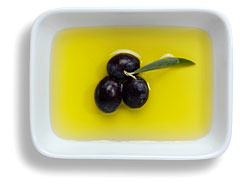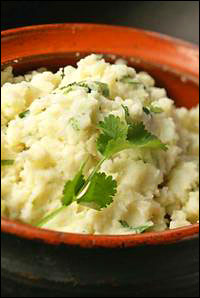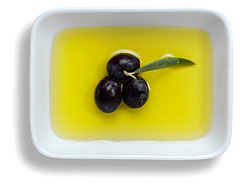I met with my friend, chef Didi Emmons, on a recent spring morning for breakfast in Harvard Square. We met at the Hi-Rise Pie Company, where we bought a loaf of potato bread and crept up the stairs to the little rooms filled with ancient chairs and tables.

Peak oil.
Didi pulled a dark green glass bottle from her rucksack. I wondered what the other patrons thought, since it was a bit early in the day for a tipple. But once we tore our loaf of bread into pieces and started dipping it in the liquid that we poured out of the bottle, I suspect they realized that the bottle contained olive oil, not some early-morning libation.
It wasn’t just any olive oil, but olive oil pressed from unripe olives grown in Tuscany, Italy’s most celebrated olive region. My previous experience with what I realize in retrospect must have been oil pressed from unripe olives was a distinctly unpleasant one. I was at a very nice Italian restaurant in L.A., and I ordered the olive oil tasting plate. When I tried the three oils that were presented, I experienced what Didi describes as “machetes down my throat.” Wow! It was like having lemon juice rubbed into esophageal paper cuts. It was hard to consume this oil on even a purely mechanical level.
And yet it is precisely this quality that makes many Tuscans seek out oil pressed from unripe olives. What seems inedible to me is a gustatory thrill for them, and they stand in line to get the oil as soon as it is available each year. Didi explained that it mellows in the bottle over time. The one we were tasting, from the 2007 harvest, had been in the bottle for several months and had a smooth flavor followed by a pleasant, peppery finish. “It doesn’t taste of olives, does it?” Didi asked me. “It tastes like a playground of all of the good things the earth has to offer: minerals, essential oil …” I interrupted her to add, “It tastes like a reduction of sunshine.”
“You get so into this oil,” Didi continued, “that you begin to think of it as a solution to all of your problems. You want to use it everywhere … you begin to think that it might taste good on top of your cereal in the morning. It’s like falling in love with a really good cheese that you want to eat all the time — except it’s healthy!”
This kind of oil is expensive, so you don’t want to use it for cooking. “Heat would make it lose its flavor,” Didi noted. “Essentially, you’re buying a sauce. Use it that way. Pour it on top of hummus, use it in a white bean purée, use it in any potato dish. Don’t use it with something that has a really strong flavor, like pesto — that would just be a waste.”
She recommends cooking with a cheaper yet still good-quality olive oil or an expeller-pressed canola oil. I use a relatively inexpensive extra-virgin organic olive oil for everyday use, and Didi likes Trader Joe’s Kalamata olive oil for uses that don’t involve high heat or strong competing flavors. In the course of my conversation with Didi, I learned that Italy had passed a new law in response to a recent counterfeit olive oil scandal. To get the full story, Didi pointed me to Rosemary Melli, an importer of artisan olive oil and also the governor of Slow Food New England. Rosemary informed me of an important new law governing the labeling of Italian extra-virgin olive oil. (To be “extra-virgin,” an olive oil must be completely cold-pressed — no heat or chemicals can be used in the chemical process.)
According to Rosemary, unscrupulous producers were making oil from sources other than olives, adding chlorophyll for a pale green color, and labeling them as extra-virgin olive oil. To protect the reputation and value of Italian extra-virgin olive oil, the government recently decreed that any Italian product labeled extra-virgin olive oil must be produced as a “single estate” oil — “meaning that the oil must be made from olives grown on the same estate where they are pressed,” Rosemary said. That means Italian olive-oil producers can no longer buy olives from unknown sources, press and bottle them, and slap a “product of Italy” and “extra-virgin olive oil” label on them.
All this talk of olive oil got me to thinking of inexpensive dishes that let olive oil shine. I remembered Didi’s recipe for skordalia — a spread made of potatoes, garlic, olive oil, and lemon juice — from her book Entertaining for a Vegetarian Planet. Anytime you can serve one carbohydrate on top of another, well, count me in. Didi’s version is made even better than the traditional rendition by adding basil and scallions.
I used a very nice organic extra-virgin olive oil from Italy that gave the location where it was grown. It cost $9.99 for 16.9 oz (about half a quart). That might seem like a lot of dough for a small bottle, but its price is quite tame compared to the fanciest available oils, which range in price from the mid-twenties to forty dollars. This recipe contains strong flavors — garlic, lemon, basil, scallion — so while it’s nice to use a good olive oil, an extraordinary one would likely be overpowered.

Spread the word.
Photo: Eddie Jim
Green Skordalia
Reprinted with permission from Didi Emmons; makes about three cups.
Kosher salt (1 1/2 teaspoons)
1/2 cup extra-virgin olive oil (nothing too special or expensive)
3-4 garlic cloves, crushed
2/3 cup packed chopped fresh basil or cilantro
1/2 cup chopped scallions, green parts only
1 tablespoon fresh lemon juice
Freshly ground black pepper
Grilled or toasted bread
- Place the potatoes in a large saucepan and add cold water to cover and salt. Bring to a boil, then reduce the heat and simmer until tender, about 25 minutes. Drain the potatoes and return them to the pan.
- Add the olive oil and garlic to the hot potatoes and mash with a potato masher until smooth. Add the basil or cilantro, scallions, and lemon juice, and mash until everything is incorporated and smooth. Stir in 1 and 1/2 teaspoons salt and the pepper.
- Transfer the skordalia to a serving bowl and serve warm or at room temperature with the grilled or toasted bread. If the mood strikes, lay a few streaks of top-quality olive oil over the top.
This dip can be prepared up to two days ahead and stored in an airtight container in the fridge.


